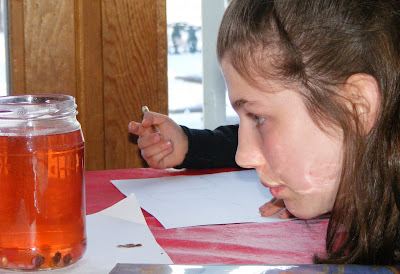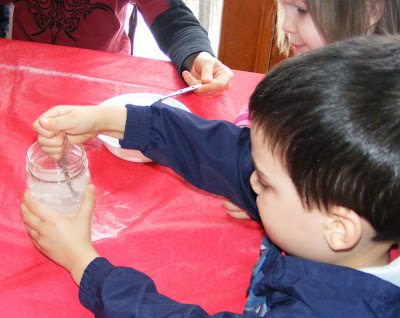This weeks Unplugged Project was float. Because of this theme it was all about science this week. I found several activities that I wanted to do with the kids so we did a different experiment on three different days last week.

The first activity was a sinking and floating experiment. We had everything on hand for this. We needed:
3 parts water
1 part vinegar
baking soda
food coloring
little items to experiment with, we used raisins, rice, popcorn, gummies,and cashews
 First we mxed the water and vinegar and then SLOWLY added a teaspoon of baking soda. (Have a towel ready at this point) We watched the fun chemical reaction, as an acid mixed with a base, forming carbon dioxide, which was given off as a gas.
First we mxed the water and vinegar and then SLOWLY added a teaspoon of baking soda. (Have a towel ready at this point) We watched the fun chemical reaction, as an acid mixed with a base, forming carbon dioxide, which was given off as a gas. Wonderful carbon dioxide.
Wonderful carbon dioxide. We added a little food coloring at this point to see how active the molecules are, the coloring immediatly dispersed throughout the water.
We then added another teaspoon of baking soda--SLOWLY.
 The kids then began adding the small items into the water to see what might happen.
The kids then began adding the small items into the water to see what might happen. In a short while carbon dioxide began to form on the items we added. As the gas built up on the popcorn it was able to lift the popcorn up from the bottom of the jar and to the surface, when it reached the surface of the water, the gas was released into the air and the popcorn fell again to the bottom of the jar.
In a short while carbon dioxide began to form on the items we added. As the gas built up on the popcorn it was able to lift the popcorn up from the bottom of the jar and to the surface, when it reached the surface of the water, the gas was released into the air and the popcorn fell again to the bottom of the jar.  Raisin worked, rice seemed to dance around, the gummies were too heavy to be lifted to the surface, little pieces of apple floated on top of our mixture, and the most active item we added were cashew nuts.
Raisin worked, rice seemed to dance around, the gummies were too heavy to be lifted to the surface, little pieces of apple floated on top of our mixture, and the most active item we added were cashew nuts. As the floating and sinking slowed down, we added more baking soda. This kept us busy watching for two hours, that is how long the "show" went on. This was a great experiment we will defininately do again.
As the floating and sinking slowed down, we added more baking soda. This kept us busy watching for two hours, that is how long the "show" went on. This was a great experiment we will defininately do again.  The next two floating experiments I found at this website.
The next two floating experiments I found at this website. This experiment was "how to float an egg in water.
We needed:
an uncooked egg
water
salt
a wide mouth jar
Above you can see our egg, which sunk in 240 ml. of regular water.
We stirred
 and stirred.
and stirred.
 And then TADA!! we put our egg back in the water and it floated on the surface.
And then TADA!! we put our egg back in the water and it floated on the surface.
 We learned that this happened because the water is now more dense than the egg, causing it to float. This also led to internet exploration of the Great Salt Lake.
We learned that this happened because the water is now more dense than the egg, causing it to float. This also led to internet exploration of the Great Salt Lake.
 After learning about density with the egg experiment, we investigated the densities of other liquids.
After learning about density with the egg experiment, we investigated the densities of other liquids.  The corn syrup, being the most dense in on the bottom. Water is next and oil is the least dense and floated on top of the water. We then added small items to see what we could get to float on the different layers. A little screw fell through all layers and laid on the bottom of our jar. A raisin fell through the oil and water, but floated on the corn syrup. Popcorn also floated on the corn syrup.
The corn syrup, being the most dense in on the bottom. Water is next and oil is the least dense and floated on top of the water. We then added small items to see what we could get to float on the different layers. A little screw fell through all layers and laid on the bottom of our jar. A raisin fell through the oil and water, but floated on the corn syrup. Popcorn also floated on the corn syrup.
 It was hard, but we finally found an item that would fall through the oil and float on the water. A little lego floated on the water. You can see it on the left side of the jar in the picture above. The lego man, however, floated on the oil. So we successfully found something to float on every layer of our jar.
It was hard, but we finally found an item that would fall through the oil and float on the water. A little lego floated on the water. You can see it on the left side of the jar in the picture above. The lego man, however, floated on the oil. So we successfully found something to float on every layer of our jar.
 and stirred.
and stirred. And then TADA!! we put our egg back in the water and it floated on the surface.
And then TADA!! we put our egg back in the water and it floated on the surface.  We learned that this happened because the water is now more dense than the egg, causing it to float. This also led to internet exploration of the Great Salt Lake.
We learned that this happened because the water is now more dense than the egg, causing it to float. This also led to internet exploration of the Great Salt Lake. After learning about density with the egg experiment, we investigated the densities of other liquids.
After learning about density with the egg experiment, we investigated the densities of other liquids. In the jar above we have from the bottom up:
corn syrup
water (with food coloring added)
oil
 The corn syrup, being the most dense in on the bottom. Water is next and oil is the least dense and floated on top of the water. We then added small items to see what we could get to float on the different layers. A little screw fell through all layers and laid on the bottom of our jar. A raisin fell through the oil and water, but floated on the corn syrup. Popcorn also floated on the corn syrup.
The corn syrup, being the most dense in on the bottom. Water is next and oil is the least dense and floated on top of the water. We then added small items to see what we could get to float on the different layers. A little screw fell through all layers and laid on the bottom of our jar. A raisin fell through the oil and water, but floated on the corn syrup. Popcorn also floated on the corn syrup. It was hard, but we finally found an item that would fall through the oil and float on the water. A little lego floated on the water. You can see it on the left side of the jar in the picture above. The lego man, however, floated on the oil. So we successfully found something to float on every layer of our jar.
It was hard, but we finally found an item that would fall through the oil and float on the water. A little lego floated on the water. You can see it on the left side of the jar in the picture above. The lego man, however, floated on the oil. So we successfully found something to float on every layer of our jar. Make sure to check out everyones Unplugged activities this week.
The theme for next week’s project will be:
Wrinkle
Wrinkle

11 comments:
WOW! You did a lot with this week's theme. I really like the way that last experiment looks.
Golly, very educational. I like the man in the oil too!
Very cool experiments. I wanted to try the syrup/water/oil experiment, but I thought we should probably talk about what float means first.
I love the first idea you posted. We will need to do this one also! You have such fantastic ideas :)
WE did the egg and salt water mixture this week also. Very fun.
We've done the layers, just never thought about floating things on the layers!
Wonderful ideas! We are definitely in a science mode right now, so we'll have to try some of these. I especially like how you tried to find things that would float on each layer of the last problem.
Great experiments! Thanks for sharing all of the step by step photos.
Wow - great! we have some cashews... I can see us playing with that experiment very soon!
What cool projects! Thanks for sharing!
We've done the bubbles one several times now because the children like it so much! I like the layers one with seeing where different things float - inspired!
We did the salt and egg experiment last year at Easter, but hadn't seen any of the others before. Looks interesting.
Post a Comment